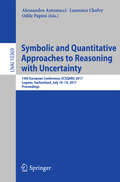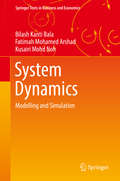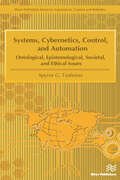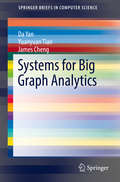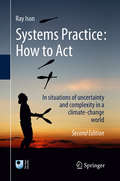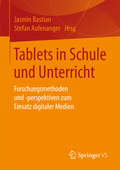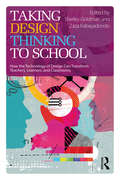- Table View
- List View
Symbolic and Quantitative Approaches to Reasoning with Uncertainty: 14th European Conference, ECSQARU 2017, Lugano, Switzerland, July 10–14, 2017, Proceedings (Lecture Notes in Computer Science #10369)
by Alessandro Antonucci Laurence Cholvy Odile PapiniThis book constitutes the refereed proceedings of the 14th European Conference on Symbolic and Quantitative Approaches to Reasoning with Uncertainty, ECSQARU 2017, held in Lugano, Switzerland, in July 2017. The 44 revised full papers presented together with 5 abstracts of invited talks were carefully reviewed and selected from 63 submissions and cover topics on analogical reasoning; argumentation; Bayesian networks; belief functions; conditionals; credal sets, credal networks; decision theory, decision making and reasoning under uncertainty; fuzzy sets, fuzzy logic; logics; orthopairs; possibilistic networks; and probabilistic logics, probabilistic reasoning.
The Symbolic Computation of Integrability Structures for Partial Differential Equations (Texts & Monographs in Symbolic Computation)
by Joseph Krasil'Shchik Alexander Verbovetsky Raffaele VitoloThis is the first book devoted to the task of computing integrability structures by computer. The symbolic computation of integrability operator is a computationally hard problem and the book covers a huge number of situations through tutorials. The mathematical part of the book is a new approach to integrability structures that allows to treat all of them in a unified way. The software is an official package of Reduce. Reduce is free software, so everybody can download it and make experiments using the programs available at our website.
System Dynamics: Modelling and Simulation (Springer Texts in Business and Economics)
by Bilash Kanti Bala Fatimah Mohamed Arshad Kusairi Mohd NohThis book covers the broad spectrum of system dynamics methodologies for the modelling and simulation of complex systems: systems thinking, causal diagrams, systems structure of stock and flow diagrams, parameter estimation and tests for confidence building in system dynamics models. It includes a comprehensive review of model validation and policy design and provides a practical presentation of system dynamics modelling. It also offers numerous worked-out examples and case studies in diverse fields using STELLA and VENSIM. The system dynamics methodologies presented here can be applied to nearly all areas of research and planning, and the simulations provided make the complicated issues more easily understandable. System Dynamics: Modelling and Simulation is an essential system dynamics and systems engineering textbook for undergraduate and graduate courses. It also offers an excellent reference guide for managers in industry and policy planners who wish to use modelling and simulation to manage complex systems more effectively, as well as researchers in the fields of modelling and simulation-based systems thinking.
System Level Design from HW/SW to Memory for Embedded Systems: 5th IFIP TC 10 International Embedded Systems Symposium, IESS 2015, Foz do Iguaçu, Brazil, November 3–6, 2015, Proceedings (IFIP Advances in Information and Communication Technology #523)
by Marcelo Götz Gunar Schirner Marco Aurélio Wehrmeister Mohammad Abdullah Al Faruque Achim RettbergThis book constitutes the refereed proceedings of the 5th IFIP TC 10 International Embedded Systems Symposium, IESS 2015, held in Foz do Iguaçu, Brazil, in November 2015. The 18 full revised papers presented were carefully reviewed and selected from 25 submissions. The papers present a broad discussion on the design, analysis and verification of embedded and cyber-physical systems including design methodologies, verification, performance analysis, and real-time systems design. They are organized in the following topical sections: cyber-physical systems, system-level design; multi/many-core system design; memory system design; and embedded HW/SW design and applications.
System Reduction for Nanoscale IC Design (Mathematics in Industry #20)
by Peter BennerThis book describes the computational challenges posed by the progression toward nanoscale electronic devices and increasingly short design cycles in the microelectronics industry, and proposes methods of model reduction which facilitate circuit and device simulation for specific tasks in the design cycle.The goal is to develop and compare methods for system reduction in the design of high dimensional nanoelectronic ICs, and to test these methods in the practice of semiconductor development. Six chapters describe the challenges for numerical simulation of nanoelectronic circuits and suggest model reduction methods for constituting equations. These include linear and nonlinear differential equations tailored to circuit equations and drift diffusion equations for semiconductor devices. The performance of these methods is illustrated with numerical experiments using real-world data. Readers will benefit from an up-to-date overview of the latest model reduction methods in computational nanoelectronics.
Systems, Cybernetics, Control, and Automation
by Spyros G. TzafestasSystems, cybernetics, control, and automation (SCCA)are four interrelated and overlapping scientific and technological fields that have contributed substantially to the development, growth, and progress of human society. A large number of models, methods, and tools were developed that assure high efficiency of SCCA applied to practical situations. The real-life applications of SCCA encompass a wide range of man-made or biological systems, including transportations, power generation, chemical industry, robotics, manufacturing, cybernetics organisms (cyborgs), aviation, economic systems, enterprise, systems, medical/health systems, environmental applications, and so on. The SCCA fields exhibit strong influences on society and rise, during their use and application, many ethical concerns and dilemmas. This book provides a consolidated and concise overview of SCCA, in a single volume for the first time, focusing on ontological, epistemological, social impact, ethical, and general philosophical issues. It is appropriate for use in engineering courses as a convenient tutorial source providing fundamental conceptual and educational material on these issues, or for independent reading by students and scientists.Included in the book is:• Background material on philosophy and systems theory• Major ontological, epistemological, societal and ethical/philosophical aspects of the four fields that are considered in the book• Over 400 references and a list of 130 additional books in the relevant fields • Over 100 colored photos and 70 line figures that illustrate the text
Systems, Cybernetics, Control, and Automation
by Spyros G. TzafestasSystems, cybernetics, control, and automation (SCCA)are four interrelated and overlapping scientific and technological fields that have contributed substantially to the development, growth, and progress of human society. A large number of models, methods, and tools were developed that assure high efficiency of SCCA applied to practical situations. The real-life applications of SCCA encompass a wide range of man-made or biological systems, including transportations, power generation, chemical industry, robotics, manufacturing, cybernetics organisms (cyborgs), aviation, economic systems, enterprise, systems, medical/health systems, environmental applications, and so on. The SCCA fields exhibit strong influences on society and rise, during their use and application, many ethical concerns and dilemmas. This book provides a consolidated and concise overview of SCCA, in a single volume for the first time, focusing on ontological, epistemological, social impact, ethical, and general philosophical issues. It is appropriate for use in engineering courses as a convenient tutorial source providing fundamental conceptual and educational material on these issues, or for independent reading by students and scientists.Included in the book is:• Background material on philosophy and systems theory• Major ontological, epistemological, societal and ethical/philosophical aspects of the four fields that are considered in the book• Over 400 references and a list of 130 additional books in the relevant fields • Over 100 colored photos and 70 line figures that illustrate the text
Systems for Big Graph Analytics (SpringerBriefs in Computer Science)
by Da Yan Yuanyuan Tian James ChengThere has been a surging interest in developing systems for analyzing big graphs generated by real applications, such as online social networks and knowledge graphs. This book aims to help readers get familiar with the computation models of various graph processing systems with minimal time investment.This book is organized into three parts, addressing three popular computation models for big graph analytics: think-like-a-vertex, think-likea- graph, and think-like-a-matrix. While vertex-centric systems have gained great popularity, the latter two models are currently being actively studied to solve graph problems that cannot be efficiently solved in vertex-centric model, and are the promising next-generation models for big graph analytics. For each part, the authors introduce the state-of-the-art systems, emphasizing on both their technical novelties and hands-on experiences of using them. The systems introduced include Giraph, Pregel+, Blogel, GraphLab, CraphChi, X-Stream, Quegel, SystemML, etc. Readers will learn how to design graph algorithms in various graph analytics systems, and how to choose the most appropriate system for a particular application at hand. The target audience for this book include beginners who are interested in using a big graph analytics system, and students, researchers and practitioners who would like to build their own graph analytics systems with new features.
Systems Practice: In situations of uncertainty and complexity in a climate-change world
by Ray IsonThis book shows how to do systems thinking and translate that thinking into praxis (theory informed practical action). It will be welcomed by those managing or governing in situations of complexity and uncertainty across all domains of professional and personal life. The development of capabilities to think and act systemically is an urgent priority. Humans are now a force of nature, affecting whole-earth dynamics including the earth's climate - we live in an Anthropocene or Capitalocene and are confronted by the emergence of a ‘post-truth’, ‘big data’ world. What we have developed, organisationally and institutionally, seems very fragile. An imperative exists to recover whatever systemic sensibilities we still retain, to foster systems literacy and to invest in systems thinking in practice capability. This will be needed in future at personal, group, community, regional, national and international levels, all at the same time.Systems Practice: How to Act is structured into four parts. Part I introduces the societal need to invest in systems thinking in practice, in contexts of uncertainty and complexity epitomised by the challenges of responding to human-induced climate change. Part II unpacks what is involved in systems practice by means of a juggler isophor; examining situations where systems thinking offers useful understanding and opportunities for change. Part III identifies the main factors that constrain the uptake of systems practice and makes the case for innovation in practice by means of systemic inquiry, systemic action research and systemic intervention. The book concludes with Part IV, which critically examines how systems practice is, or might be, utilised at different levels from the personal to the societal.
Systems, Software and Services Process Improvement: 24th European Conference, EuroSPI 2017, Ostrava, Czech Republic, September 6–8, 2017, Proceedings (Communications in Computer and Information Science #748)
by Jakub Stolfa Svatopluk Stolfa Rory V. O'Connor Richard MessnarzThis volume constitutes the refereed proceedings of the 24th EuroSPI conference, held in Ostrava, Czech Republic, in September 2017.The 56 revised full papers presented were carefully reviewed and selected from 97 submissions. They are organized in topical sections on SPI and VSEs, SPI and process models, SPI and safety, SPI and project management, SPI and implementation, SPI issues, SPI and automotive, selected key notes and workshop papers, GamifySPI, SPI in Industry 4.0, best practices in implementing traceability, good and bad practices in improvement, safety and security, experiences with agile and lean, standards and assessment models, team skills and diversity strategies.
Tableau 10 Bootcamp: Intensive training for data visualization and dashboarding
by Donabel Santos Joshua N. MilliganSharpen your data visualization skills with Tableau 10 Bootcamp. About This Book • Make informed decisions using powerful visualizations in Tableau • Learn effective data storytelling to transform how your business uses ideas • Use this extensive bootcamp that makes you an efficient Tableau user in a short span of time Who This Book Is For This book caters to business, data, and analytics professionals who want to build rich interactive visualizations using Tableau Desktop. Familiarity with previous versions of Tableau will be helpful, but not necessary. What You Will Learn • Complete practical Tableau tasks with each chapter • Build different types of charts in Tableau with ease • Extend data using calculated fields and parameters • Prepare and refine data for analysis • Create engaging and interactive dashboards • Present data effectively using story points In Detail Tableau is a leading visual analytics software that can uncover insights for better and smarter decision-making. Tableau has an uncanny ability to beautify your data, compared to other BI tools, which makes it an ideal choice for performing fast and easy visual analysis. A military camp style fast-paced learning book that builds your understanding of Tableau 10 in no time. This day based learning guide contains the best elements from two of our published books, Learning Tableau 10 - Second Edition and Tableau 10 Business Intelligence Cookbook, and delivers practical, learning modules in manageable chunks. Each chunk is delivered in a "day", and each "day" is a productive day. Each day builds your competency in Tableau. You will increase your competence in integrating analytics and forecasting to enhance data analysis during the course of this Bootcamp. Each chapter presents core concepts and key takeaways about a topic in Tableau and provides a series of hands-on exercises. In addition to these exercises, at the end of the chapter, you will find self-check quizzes and extra drills to challenge you, to take what you learned to the next level. To summarize, this book will equip you with step-by-step instructions through rigorous tasks, practical callouts, and various real-world examples and assignments to reinforce your understanding of Tableau 10. Style and approach A fast paced book filled with highly-effective real-world examples to help you build new things and help you in solving problems in newer and unseen ways.
Tablets in Schule und Unterricht: Forschungsmethoden und -perspektiven zum Einsatz digitaler Medien
by Jasmin Bastian Stefan AufenangerDer Band liefert erste Forschungsergebnisse zu den erweiterten Möglichkeiten schülerzentrierten Unterrichts mit mobilen Medien. Der Überblick über die aktuelle Tabletforschung greift nationale und internationale Entwicklungen auf und versteht sich als Grundlage für eine konstruktive Auseinandersetzung im fachwissenschaftlich-pädagogischen und öffentlichen Diskurs.
Tabular Modeling with SQL Server 2016 Analysis Services Cookbook
by Derek WilsonExpert tabular modeling techniques for building and deploying cutting-edge business analytical reporting solutions About This Book • Build and deploy Tabular Model projects from relational data sources • Leverage DAX and create high-performing calculated fields and measures • Create ad-hoc reports based on a Tabular Model solution • Useful tips to monitor and optimize your tabular solutions Who This Book Is For This book is for SQL BI professionals and Architects who want to exploit the full power of the new Tabular models in Analysis Services. Some knowledge of previous versions of Analysis services would be helpful but is not essential. What You Will Learn • Learn all about Tabular services mode and how it speeds up development • Build solutions using sample datasets • Explore built-in actions and transitions in SSAS 2016 • Implement row-column, and role-based security in a Tabular Data model • Realize the benefits of in-memory and DirectQuery deployment modes • Get up to date with the new features added to SQL Server 2016 Analysis Services • Optimize Data Models and Relationships Usage In Detail SQL Server Analysis Service (SSAS) has been widely used across multiple businesses to build smart online analytical reporting solutions. It includes two different types of modeling for analysis services: Tabular and Multi Dimensional. This book covers Tabular modeling, which uses tables and relationships with a fast in-memory engine to provide state of the art compression algorithms and query performance. The book begins by quickly taking you through the concepts required to model tabular data and set up the necessary tools and services. As you learn to create tabular models using tools such as Excel and Power View, you'll be shown various strategies to deploy your model on the server and choose a query mode (In-memory or DirectQuery) that best suits your reporting needs. You'll also learn how to implement key and newly introduced DAX functions to create calculated columns and measures for your model data. Last but not least, you'll be shown techniques that will help you administer and secure your BI implementation along with some widely used tips and tricks to optimize your reporting solution. By the end of this book, you'll have gained hands-on experience with the powerful new features that have been added to Tabular models in SSAS 2016 and you'll be able to improve user satisfaction with faster reports and analytical queries. Style and approach This book takes a practical, recipe-based approach where each recipe lists the steps to address or implement a solution. You will be provided with several approaches to creating a business intelligence semantic model using analysis services.
Tactile Display for Virtual 3D Shape Rendering (SpringerBriefs in Applied Sciences and Technology)
by Alessandro Mansutti Mario Covarrubias Rodriguez Monica Bordegoni Umberto CuginiThis book describes a novel system for the simultaneous visual and tactile rendering of product shapes which allows designers to simultaneously touch and see new product shapes during the conceptual phase of product development. This system offers important advantages, including potential cost and time savings, compared with the standard product design process in which digital 3D models and physical prototypes are often repeatedly modified until an optimal design is achieved. The system consists of a tactile display that is able to represent, within a real environment, the shape of a product. Designers can explore the rendered surface by touching curves lying on the product shape, selecting those curves that can be considered style features and evaluating their aesthetic quality. In order to physically represent these selected curves, a flexible surface is modeled by means of servo-actuated modules controlling a physical deforming strip. The tactile display is designed so as to be portable, low cost, modular, and high performing in terms of the types of shape that it can represent.
Tagungsband des 2. Kongresses Montage Handhabung Industrieroboter
by Thorsten Schüppstuhl Jörg Franke Kirsten TrachtDer MHI e.V. ist ein Netzwerk leitender Universitätsprofessoren aus dem deutschsprachigen Raum, die sowohl grundlagenorientiert als auch anwendungsnah in der Montage, Handhabung und Industrierobotik erfolgreich forschend tätig sind. Die Gründung der Gesellschaft erfolgte im Frühjahr 2012. Der MHI e.V. hat derzeit 20 Mitglieder, die über ihre Institute und Lehrstühle zurzeit ca. 1.000 Wissenschaftler repräsentieren.Die übergeordnete Zielsetzung des MHI e.V. ist die Förderung der Zusammenarbeit von deutschsprachigen Wissenschaftlerinnen und Wissenschaftlern untereinander, sowie mit der Industrie im Bereich Montage, Handhabung und Industrierobotik zur Beschleunigung der Forschung, Optimierung der Lehre und zur Verbesserung der internationalen Wettbewerbsfähigkeit der deutschen Industrie in diesem Bereich.Das Kolloquium fokussiert auf einen akademischen Austausch auf hohem Niveau, um die gewonnenen Forschungsergebnisse zu verteilen, synergetische Effekte und Trends zu bestimmen, die Akteure persönlich zu verbinden und das Forschungsfeld sowie die MHI-Gemeinschaft zu stärken.
Taking Design Thinking to School: How the Technology of Design Can Transform Teachers, Learners, and Classrooms
by Shelley Goldman Zaza KabayadondoDesign thinking is a method of problem-solving that relies on a complex set of skills, processes and mindsets that help people generate novel solutions to problems. Taking Design Thinking to School: How the Technology of Design Can Transform Teachers, Learners, and Classrooms uses an action-oriented approach to reframing K-12 teaching and learning, examining interventions that open up dialogue about when and where learning, growth, and empowerment can be triggered. While design thinking projects make engineering, design, and technology fluency more tangible and personal for a broad range of young learners, their embrace of ambiguity and failure as growth opportunities often clash with institutional values and structures. Through a series of in-depth case studies that honor and explore such tensions, the authors demonstrate that design thinking provides students with the agency and compassion that is necessary for doing creative and collaborative work, both in and out of the classroom. A vital resource for education researchers, practitioners, and policymakers, Taking Design Thinking to School brings together some of the most innovative work in design pedagogy.
Taking Design Thinking to School: How the Technology of Design Can Transform Teachers, Learners, and Classrooms
by Shelley Goldman Zaza KabayadondoDesign thinking is a method of problem-solving that relies on a complex set of skills, processes and mindsets that help people generate novel solutions to problems. Taking Design Thinking to School: How the Technology of Design Can Transform Teachers, Learners, and Classrooms uses an action-oriented approach to reframing K-12 teaching and learning, examining interventions that open up dialogue about when and where learning, growth, and empowerment can be triggered. While design thinking projects make engineering, design, and technology fluency more tangible and personal for a broad range of young learners, their embrace of ambiguity and failure as growth opportunities often clash with institutional values and structures. Through a series of in-depth case studies that honor and explore such tensions, the authors demonstrate that design thinking provides students with the agency and compassion that is necessary for doing creative and collaborative work, both in and out of the classroom. A vital resource for education researchers, practitioners, and policymakers, Taking Design Thinking to School brings together some of the most innovative work in design pedagogy.
Talking to Artists / Talking to Programmers: How to Get Programmers and Artists Communicating
by Wendy DespainArtists and programmers often work together on complex projects in stressful environments and things don’t always go smoothly. Miscommunication and misunderstandings are common as these two disciplines often use the same words to mean different things when they talk to each other. Unintentional slights can turn into long-held grudges and productivity grinds to a crawl. This is a "flip book" that contains two narratives in one. Turn the book one way and read one perspective; turn the book over and upside down and read the other perspective. The narratives can be read separately, one after the other, or in alternating chapters. Talking to Artists / Talking to Programmers can help anyone who wants to improve communication with artists and programmers. It’s set up like a foreign language dictionary, so it addresses the cultural norms, attitudes and customs surrounding the words each group uses, so you’ll know not just what the words in the glossary mean, you’ll know why they’re used that way and how to get communication flowing again. It addresses common reasons for communication problems between these two groups and provides specific suggestions for solutions. The unusual format allows for each side to be given equal weight - learn how to talk to artists starting on one side of the book, turn it over and learn how to talk to programmers. The whole book stresses the things artists and programmers have in common. Focused primarily on videogame developers, it also applies to other fields where tech and art have to work together, including web developers and teams building mobile apps. Anyone who wants to communicate better with programmers or artists - this book can help Features Lists of common problems and strategies for solving them Specific ideas for building bridges between departments Case studies from real teams Glossary of terms causing the most confusion Explanations for common friction points Approaches for fostering goodwill Solutions for team dynamics problems Specific suggestions for providing feedback Ideas for holding successful meetings
Talking to Artists / Talking to Programmers: How to Get Programmers and Artists Communicating
by Wendy DespainArtists and programmers often work together on complex projects in stressful environments and things don’t always go smoothly. Miscommunication and misunderstandings are common as these two disciplines often use the same words to mean different things when they talk to each other. Unintentional slights can turn into long-held grudges and productivity grinds to a crawl. This is a "flip book" that contains two narratives in one. Turn the book one way and read one perspective; turn the book over and upside down and read the other perspective. The narratives can be read separately, one after the other, or in alternating chapters. Talking to Artists / Talking to Programmers can help anyone who wants to improve communication with artists and programmers. It’s set up like a foreign language dictionary, so it addresses the cultural norms, attitudes and customs surrounding the words each group uses, so you’ll know not just what the words in the glossary mean, you’ll know why they’re used that way and how to get communication flowing again. It addresses common reasons for communication problems between these two groups and provides specific suggestions for solutions. The unusual format allows for each side to be given equal weight - learn how to talk to artists starting on one side of the book, turn it over and learn how to talk to programmers. The whole book stresses the things artists and programmers have in common. Focused primarily on videogame developers, it also applies to other fields where tech and art have to work together, including web developers and teams building mobile apps. Anyone who wants to communicate better with programmers or artists - this book can help Features Lists of common problems and strategies for solving them Specific ideas for building bridges between departments Case studies from real teams Glossary of terms causing the most confusion Explanations for common friction points Approaches for fostering goodwill Solutions for team dynamics problems Specific suggestions for providing feedback Ideas for holding successful meetings
Task Scheduling for Multi-core and Parallel Architectures: Challenges, Solutions and Perspectives
by Quan Chen Minyi GuoThis book presents task-scheduling techniques for emerging complex parallel architectures including heterogeneous multi-core architectures, warehouse-scale datacenters, and distributed big data processing systems. The demand for high computational capacity has led to the growing popularity of multicore processors, which have become the mainstream in both the research and real-world settings. Yet to date, there is no book exploring the current task-scheduling techniques for the emerging complex parallel architectures. Addressing this gap, the book discusses state-of-the-art task-scheduling techniques that are optimized for different architectures, and which can be directly applied in real parallel systems. Further, the book provides an overview of the latest advances in task-scheduling policies in parallel architectures, and will help readers understand and overcome current and emerging issues in this field.
Taxonomy Matching Using Background Knowledge: Linked Data, Semantic Web and Heterogeneous Repositories
by Heiko Angermann Naeem RamzanThis important text/reference presents a comprehensive review of techniques for taxonomy matching, discussing matching algorithms, analyzing matching systems, and comparing matching evaluation approaches. Different methods are investigated in accordance with the criteria of the Ontology Alignment Evaluation Initiative (OAEI). The text also highlights promising developments and innovative guidelines, to further motivate researchers and practitioners in the field.Topics and features: discusses the fundamentals and the latest developments in taxonomy matching, including the related fields of ontology matching and schema matching; reviews next-generation matching strategies, matching algorithms, matching systems, and OAEI campaigns, as well as alternative evaluations; examines how the latest techniques make use of different sources of background knowledge to enable precise matching between repositories; describes the theoretical background, state-of-the-art research, and practical real-world applications; covers the fields of dynamic taxonomies, personalized directories, catalog segmentation, and recommender systems.This stimulating book is an essential reference for practitioners engaged in data science and business intelligence, and for researchers specializing in taxonomy matching and semantic similarity assessment. The work is also suitable as a supplementary text for advanced undergraduate and postgraduate courses on information and metadata management.
TCP 2014: Proceedings of the 6th International Conference on Trapped Charged Particles and Fundamental Physics, held in Takamatsu, Japan, 1-5, December 2014
by Michiharu Wada Peter Schury Yuichi IchikawaThis volume presents the proceedings of the International Conference on Trapped Charged Particles and Fundamental Physics (TCP 14). It presents recent developments in the theoretical and experimental research on trapped charged particles and related fundamental physics and applications. The content has been divided topic-wise covering basic questions of Fundamental Physics, Quantum and QED Effects, Plasmas and Collective Behavior and Anti-Hydrogen. More technical issues include Storage Ring Physics, Precision Spectroscopy and Frequency Standards, Highly Charged Ions in Traps, Traps for Radioactive Isotopes and New Techniques and Facilities. An applied aspect of ion trapping is discussed in section devoted to Applications of Particle Trapping including Quantum Information and Processing. Each topic has a more general introduction, but also more detailed contributions are included. A selection of contributions exemplifies the interdisciplinary nature of the research on trapped charged particles worldwide. Reprinted from Hyperfine Interactions (HYPE) Volumes 235, Issue 1-3 and 236, Issue 1-3.
Teach Yourself VISUALLY iPhone 7: Covers iOS 10 and all models of iPhone 6s, iPhone 7, and iPhone SE (Teach Yourself VISUALLY (Tech))
by Guy Hart-DavisA visual guide to the latest iPhone technology Teach Yourself VISUALLY iPhone is the visual guide to mastering the powerful features and functionality of Apple's latest smartphone. Whether you're a newbie or upgrading to the latest model, this easy to navigate guide features visually rich tutorials and plenty of step-by-step instructions to help you make sense of all your iPhone's capabilities—from the most basic to the most advanced. Covering all the exciting features of the latest cutting-edge models, this visual guide helps you learn how to access and download apps, books, music, and video content; send photos and emails; edit movies; synch with Apple devices and services; effectively use the current OS; and much more. Learn the features of iOS with 500 full-color screen shots Master the basic functions of your iPhone and customize its settings to work the way you prefer Ensure you're getting optimal performance from your iPhone Discover how to find the best apps and services to fit your personal and business needs If you learn faster by seeing and doing, this visual guide will quickly help you unlock the many capabilities of the world's favorite smartphone.
Teach Yourself VISUALLY iPhone 7: Covers iOS 10 and all models of iPhone 6s, iPhone 7, and iPhone SE (Teach Yourself VISUALLY (Tech))
by Guy Hart-DavisA visual guide to the latest iPhone technology Teach Yourself VISUALLY iPhone is the visual guide to mastering the powerful features and functionality of Apple's latest smartphone. Whether you're a newbie or upgrading to the latest model, this easy to navigate guide features visually rich tutorials and plenty of step-by-step instructions to help you make sense of all your iPhone's capabilities—from the most basic to the most advanced. Covering all the exciting features of the latest cutting-edge models, this visual guide helps you learn how to access and download apps, books, music, and video content; send photos and emails; edit movies; synch with Apple devices and services; effectively use the current OS; and much more. Learn the features of iOS with 500 full-color screen shots Master the basic functions of your iPhone and customize its settings to work the way you prefer Ensure you're getting optimal performance from your iPhone Discover how to find the best apps and services to fit your personal and business needs If you learn faster by seeing and doing, this visual guide will quickly help you unlock the many capabilities of the world's favorite smartphone.
Teach Yourself VISUALLY macOS Sierra
by Paul McFedriesGet to know MacOS Sierra with this visual expert guide Teach Yourself VISUALLY macOS Sierra is your ideal guide to the new Mac operating system. Clear, step-by-step instructions walk you through setup, show you around, and help you get down to work—but first you'll have a little fun. Sierra brings Siri to the desktop, provides seamless access across devices, allows you to copy from one device and paste to another, and so much more. This guide takes you through the beautiful, functional, simplicity that is the macOS workflow, with straightforward explanations, step-by-step demonstration, and rich, easy-to-follow visuals. From essential everyday tasks to the specialized "tricks" you can only find on a Mac, you'll know Sierra inside-out in a flash. Expert instruction is the key to getting the most out of any tool, and your Mac is a tool like no other. Connect, create, enjoy, and more with fewer clicks, fewer issues, and much less confusion than any other operating system. This book is your personal guide to exploring and using macOS Sierra. Set up seamless contacts, email, and calendars, Messages, and FaceTime Find your way around Mission Control, Launchpad, Dashboard, and Time Machine Organize photos, video, movies, music, and files, on your Mac or in the cloud Secure, customize, and maintain your Mac for flawless functionality Get streamlined, get organized, and get going: macOS Sierra helps you work, play, and live better with features and capabilities designed for the way you operate. Teach Yourself VISUALLY macOS Sierra walks you through what you need to know to experience everything your Mac has to offer.
